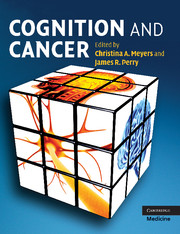Book contents
- Frontmatter
- Contents
- List of contributors
- Preface
- Section 1 Cognition and the brain: measurement, tools, and interpretation
- 1 Introduction
- 2 Clinical neuropsychology
- 3 Brain imaging investigation of chemotherapy-induced neurocognitive changes
- 4 Role of neuropsychological assessment in cancer patients
- 5 Neuropsychological assessment of adults with cancer
- 6 Neuropsychological assessment of children with cancer
- Section 2 Effects of cancer and cancer treatment on cognition
- Section 3 Interventions and implications for clinical trials
- Index
- Plate section
- References
2 - Clinical neuropsychology
Published online by Cambridge University Press: 13 August 2009
- Frontmatter
- Contents
- List of contributors
- Preface
- Section 1 Cognition and the brain: measurement, tools, and interpretation
- 1 Introduction
- 2 Clinical neuropsychology
- 3 Brain imaging investigation of chemotherapy-induced neurocognitive changes
- 4 Role of neuropsychological assessment in cancer patients
- 5 Neuropsychological assessment of adults with cancer
- 6 Neuropsychological assessment of children with cancer
- Section 2 Effects of cancer and cancer treatment on cognition
- Section 3 Interventions and implications for clinical trials
- Index
- Plate section
- References
Summary
Neuropsychology is a specialized area of study within the field of psychology that focuses on brain–behavior relations, most particularly involving structural–functional connections between the nervous system and mental behavior. Outside of psychology, its closest allies are behavioral neurology, functional neuroanatomy, neuropsychiatry, speech and language pathology, and, more recently, cognitive neuroscience. A distinction may be made between clinical and experimental neuropsychology, although these branches are complementary, as evidenced by a large number of neuropsychologists who identify themselves as clinical researchers and work as true scientist practitioners. For example, neuropsychological rehabilitation generally includes diagnosis and treatment (both clinical) as well as outcome studies (research) assessing the efficacy of various interventions. Clinical neuropsychology refers to the practice of neuropsychological evaluation of individuals with known or suspected brain damage. Clinical neuropsychologists typically work in hospital settings or private clinics where they administer standardized, clinical neuropsychological measures to patients referred by physicians, school systems, or insurance companies. Experimental neuropsychology is the descriptive term for the academic branch of neuropsychology that focuses on research rather than clinical service delivery. Experimental neuropsychologists typically work in universities or teaching hospitals where they may develop their own test stimuli and procedures or administer clinical neuropsychological instruments either to healthy individuals with presumptively normal cognition or to patients with known or suspected brain damage. When experimental neuropsychologists administer clinical instruments to patients, however, it is most often to advance understanding of the cognitive processes involved in performing a particular task or for the comparison of cognitive processes in different patient groups rather than for diagnostic purposes.
- Type
- Chapter
- Information
- Cognition and Cancer , pp. 6 - 18Publisher: Cambridge University PressPrint publication year: 2008
References
- 1
- Cited by



